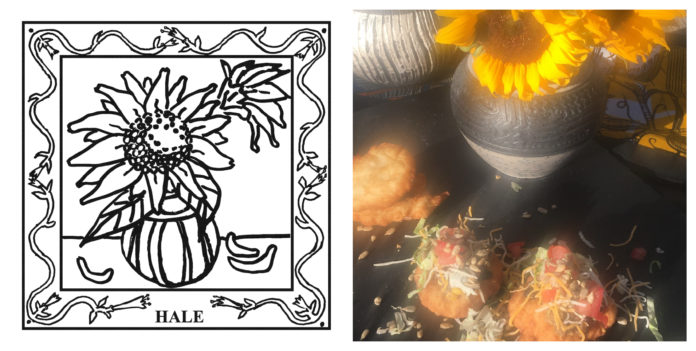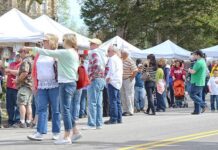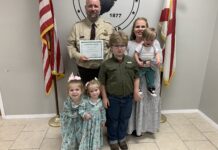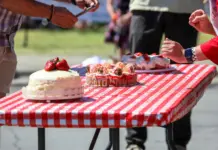
The Cullman Tribune is celebrating the Alabama Bicentennial (1819-2019) with statewide field reporting by Alabama Master Gardener/Botanical Artist Ben Johnson South. This year-long feature, “The 67-County Alabama Garden Party,” will spotlight different counties each week. Each county will get its own “quilt block,” along with a historical profile, and we’ll share a recipe specific to the area. At the end of the year, all 67 counties will be put in a book to commemorate the Bicentennial.
Hale County
A thousand years ago, the people of Hale County, Alabama ate sunflowers.
The most distinctive trait of us Alabamians is that we view time differently. While it is considered very American to wholesale accept that moving forward is progress, we Alabamians believe there are some things from the past, like manners, that we want to carry into the future with us. People in Hale County take the long view of history.
Alabama embraces innovation; we are leaders in space travel and medical research. We are time-weavers comfortable with one foot on the launching pad to the moon and the other on a Hale County mound of the nature-worshiping ancients.
Hale County is honoring the state’s Bicentennial this year, a celebration of Alabama being a mapped, recognized area of the United States of America for 200 years. However, there is an everyday awareness for those growing up and living in this remote part of the state that a great civilization of people lived here, 800 years before the land was claimed by European settlers.
At present day Moundville, Alabama in Hale County there was a major settlement of the Mississippian Native Americans and one of the most important hubs for religion and politics on the North American continent. The culture existed between the 11th and 16th centuries. However, few mounds were constructed before 1200 A.D. And, by 1500 A.D., the mounds were mostly abandoned as residences and became ceremonial places for spiritual practices and governmental matters.
When you stand on the mounds of this 185-acre “lost city” on the bluffs of the Black Warrior River you can still see pine forests, occasional deer, rabbits, maritime magnolias, a great variety of birds and groves of hickory and oak trees. There are 29 platform mounds around a grassy rectangular plaza. It is estimated 1,000 people lived inside the wooden walls of the main area and 10,000 in the surrounding woodlands.
The mound-dwelling residents were skilled plants-people. Agriculture was the main source for food augmented by fishing and hunting. The main crop was maize (corn). Because these people were talented and knowledgeable farmers, they grew a surplus of maize which provided exports for trading with other native populations. The archaeological site in Hale County, now managed by the University of Alabama (Tuscaloosa) is also renowned for the beauty and utility of its pottery and stonework.
Sunflowers were another popularly cultivated plant crop in the ancient gardens of what is now Hale County. Sunflowers have been called the “fourth sister” which refers to the “Three Sisters” of edible plants: corn, beans and squash. The native people ate sunflower seeds and other parts of the plant for the nutritious fat content.
Food archaeologists believe the diet of the Mississippian mound dwellers was 40% corn. Besides this plant, the other cultivated vegetation was primarily squash, sunflowers, chenopod, maygrass (Phalaris caroliniana), barley and beans. Wild food foraged included hickory nuts, acorns, persimmons and native grapes.
Fish provided 25% of the dwellers’ protein and was the most common animal eaten. Other meats included venison, beaver, turkey, rabbit, squirrel, opossum and turtle. The upper class of the mound dwellers and men ate more meat than those of lesser status and women.
Sunflowers were valued by the militaristic warriors centuries ago in Hale County. The golden petals were ground into powder and worn as war paint for courage. Natives of the Mississippian culture often carried sunflower cakes into battle as “power bars” to keep their strength up and be victorious. And, sunflower oil was used as a medicine for treating wounds.
Most reading this are not literally in arm-to-arm combat with neighboring tribes in the 21st century, but here are some good reasons for us to plant sunflowers in modern times:
- SUNFLOWERS FEED POLLINATORS- A goal I have in the new year is to inspire more “pollinator gardens” in Alabama, at least one in each of the 67 counties. Sunflowers would be an ideal plant for such gardens because the big petals attract honeybees, bumblebees and butterflies and then the florets at the center of the heads have nectar and pollen which is a food source for these busy pollinators.
- SUNFLOWERS ARE BEAUTIFUL CUT FLOWERS- Few things are more smile-inducing than a vase or jug of these big, happy blossoms; remember to plunge freshly cut sunflower stems into a clean bucket of water so the stems don’t seal.
- SUNFLOWERS PROVIDE “FREE” EDIBLE SEEDS- and are a high-energy snack, add crunch and nutrients to salads, and also a good substitute for pine nuts in pesto. You can also enjoy the nutty flavor and nutritional boost of sunflowers harvested young as microgreens.
- SUNFLOWERS ATTRACT BIRDS- which devour insect pests. If you raise chickens, sunflowers are a perfect treat for them; just toss a sunflower head into their area and they’ll peck the daylights out of it and cluck for more.
- SUNFLOWERS IMPROVE SOIL- Especially in more urban areas, there is often lead, arsenic, copper and other soil-contaminants. When planted in mass, sunflowers are not only beautiful, but the dirt they are planted in is being improved by these hyper-accumulators.
Here are other positive and pleasurable PLANTS + PEOPLE things in Hale County to explore on your 67-County, Alabama Garden Party tour, including an original recipe by Laurie Johnson that combines traditional Native American fry bread with venison and a sprinkling of sunflower seeds.
*GREENSBORO FARMERS’ MARKET- Intersection of Highway 14 and Highway 61, Greensboro, AL 36744; open Fridays 7 a.m.-1 p.m., May 31-Sept. 27
*PIE LAB- The nationally celebrated innovation hub has this recipe for success: PIE + COMMUNITY CENTER + DESIGN STUDIO; see major articles on Pie Lab in The New York Times Magazine, Southern Living Magazine and other media; 1317 Main Street, Greensboro, AL 36744, 334-624-3899
*HALE COUNTY PLANTS ADVICE/EDUCATION- 701 Hall St., Greensboro, AL 36744, 334-624-8710
*PLANTING AN IDEA- Have an artists’ competition to design a 21st century site-specific “earthwork” in Hale County. I’m thinking here of Maya Lin’s “Eleven Minute Mile” created on a dairy farm in Sweden. Also, the ziggurat mounds which were the signature of garden designer Anthea Gibson. Such an artwork could create another reason for plant tourists, art lovers and the general public to visit this beautiful, 10 centuries-inhabited part of Alabama. The new “earthwork” could be on land contiguous with the protected archaeological site or in another part of the county.
Y’ALL COME to Hale County on your 67-County, Alabama Garden Party tour! It’s mounds of fun, adventure, history and beauty.
Many thanks to Laurie Johnson for her original Hale County Fry Bread Tacos, which I’m having with wild deer venison, Alabama-grown greens and sunflower seeds from a “pollinator garden.”
Hale County Fry Bread Tacos
We all love tacos and most of us think of them to be strictly of Mexican origin. But our Native American foregoers thrived on a very similar meal of spiced meat on a base of fried bread (not a tortilla) topped with vegetables and seeds. This recipe calls for ground venison, a meat with which Alabama Native Americans were familiar, but it can be substituted with any taco meat that you wish. The fry breads are really the star of this dish. So easy- only two ingredients plus the oil for frying. They turn out fluffy but crisp and are the perfect base for a perfect taco. Top yours as you like, enjoy and say a little prayer of respect and thanks to our Native American foregoers.
Ingredients:
- For taco meat mixture
- 1 lb. ground venison (or beef, chicken or turkey if you can’t get venison)
- 1 small yellow onion, chopped
- Vegetable or olive oil as needed
- Taco meat seasonings – Use a mix packet or your own using earthy flavors like cumin, chili powder, onion powder, garlic powder, paprika and salt and pepper.
- 2 tbsp. cornmeal if not using a seasoning packet
- Whole kernel corn (fresh off the cob or frozen) and black beans, rinsed and drained well
- For fry breads
- 2 cups self-rising flour, plus a little more for pressing out the breads
- 1 cup buttermilk
- 2-3 cups vegetable oil for frying
- Toppings of your choice – shredded cheese, lettuce, chopped tomatoes, sour cream and shelled, roasted sunflower seeds
Instructions:
- Pre-heat oven to its warm setting or ~ 200F.
- Prep and keep your chosen toppings to serve once the fry breads and meat are ready.
- Meat Mixture – Brown ground venison with chopped onion (and a little oil since venison is so lean) until browned and onion is soft. Add taco seasonings, a little water and cornmeal (if not using a mix) and simmer until flavors are well mixed and thickened. On a hot grill pan with a little oil, grill the corn kernels and black beans until almost charred. Mix into the meat, simmer a little more and then cover and keep warm.
- Fry Breads – Mix self-rising flour and buttermilk. The mixture will be still sticky – resist adding more flour in this step. On a well-floured surface and with flour on your hands, press ~3-inch balls of dough into ~ 5-inch circles. Add enough extra flour from the surface or your hands so they are easy to handle but not too dry. This step is a bit messy, but surprisingly easy. Heat about 3 inches of vegetable oil in a sauce pan or Dutch oven until a dab of dough sizzles and rises but doesn’t immediately turn dark. Carefully drop in the dough circles, one or two at a time and fry until golden – turning with a heat-proof spatula after a minute or two on each side. They will expand as they cook, so don’t crowd the pan. Remove and drain on layers of paper towels on an oven-proof pan. Cover loosely with foil and keep in warm oven until serving.
- Plate the warm fry bread, topped with the venison mixture and your chosen toppings to enjoy a taco like our Native American foregoers might have.
Also, check out Alabama Bicentennial: 200 ways to save Alabama for the next 200 years.
Copyright 2019 Humble Roots, LLC. All Rights Reserved.




























